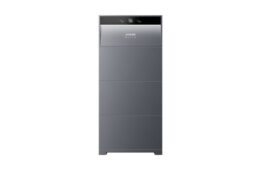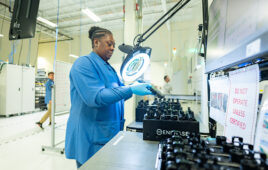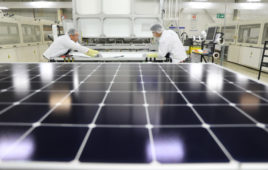SolarEdge has issued the following response to SMA’s claim based on a study by the University of Southern Denmark (SDU) that in almost all applications, a PV system with string optimization technology can achieve greater energy production than a system with traditional DC optimizers:
“In relation to the recent published study on MLPE, a study conducted by a researcher who is a previous Danfoss Solar inverter employee (which was acquired by SMA), we believe that there are a number of issues regarding the manner in which the study was conducted.
“The testing conditions in the study are stated to be ‘extreme scenarios’ which the study purports to be have been chosen ‘where optimizers are expected to bring the highest benefits.’ This is a false expectation and the scenarios are not indicative of real rooftop or ground-mount PV sites.
“Below is further detail on some of the problematic areas of the study, which call into question its integrity and conclusions:
- Insufficient test duration: Seasonal variations are not taken into account, which would be required in order to properly quantify the overall effects of shading or orientation variations.
- Exclusion of key data: Data such as PV module power deviations are excluded from the study. This is of particular concern since the standard power deviations (mismatch) of PV modules are actually higher than the differences reported in the test results.
- Handpicking data: The report specifically handpicks days, which misrepresents findings, instead of using averages for the test duration.
- Inadequate testing quantity: Only 14 modules were tested per system in each scenario and the same modules were used in all scenarios. This sample size does not have enough statistical significance to extrapolate meaningful conclusions on the behavior of PV systems.
- Scenarios used in study are not true to life or are unrealistic: For example, the multiple module orientations scenario was simulated by covering only one PV module in a string with a thin cotton sheet. This would not create a different irradiance curve throughout the day, like a different orientated module would in the real world. A second example is the placement of a large pole directly in front of PV modules to cause shading. This simply tests bypass diodes, not module level mismatch.
“In addition, we reached out directly to the author of the study, and requested the raw data on which the study is based. He refused to provide the data. In addition, he readily admitted in his reply that, “In this case it is not the added value for the module level optimized PV systems, because the shadow is not effecting the three systems equally. Basically the modules with optimizers are firstly effected by the shading and therefore have less yield compared to the other optimizer system and the system without optimizers.” This shows that the shade effect on each system that was compared was not identical.
“The flaws mentioned, compounded by the author’s unwillingness to provide transparency into the data and his admission on the inequality of the test, should cause considerable doubt about how this research was conducted and its conclusions.
“The value of power optimizers has been demonstrated by numerous pieces of research conducted by reputable, professional and objective organizations throughout the years. In addition to these studies, the market continues to recognize the value of DC optimization by choosing SolarEdge, which is why we are the global inverter leader. Some of the studies throughout the years that have reviewed and demonstrated the value of power optimizers include:
- Photon Magazine performed an independent study that showed that power optimizers increase energy yield in both shaded and non-shaded scenarios.
- National Renewable Energy Laboratory (NREL) had PV Evolutions Lab (PVEL) conduct a study that found that the SolarEdge system outperformed a previously leading standard inverter and microinverter systems.
- Another recent study published by the University of Gayle in 2019 yet again confirmed these findings. In the study, SolarEdge power optimizers demonstrated a 2% energy gain for light shade and up to 8.5% under more severe shading, in comparison to a traditional string inverter system.”
News item from SolarEdge




A manufacturer has an issue with a test that makes its product inferior to the other tested products? Shocker.
From this article: “(PVEL) conduct a study that found that the SolarEdge system outperformed a previously leading standard inverter and microinverter systems.”
In the PVEL study, SE beat out SMA by 2%, 5%, and 8% in light, moderate and heavy shade. SE outperformed Enphase by 1-2%.
Interestingly enough, PVEL also conducted studies, sponsored by Enphase, where Enphase beat out SMA and SE. Wow, go figure! Again, the amounts were small in comparison.
Enphase vs. SE: https://enphase.com/sites/default/files/Enphase_SolarEdgeSideBySideStudy.pdf
Enphase vs. SMA: https://enphase.com/sites/default/files/Study_Comparing_Enphase_and_SMA.pdf
Read that again. PVEL conducted studies that found in favor of the manufacturer that sponsored them.
But wait! Fronius conducted a study between their inverter and SE and they corroborate SMA’s conclusion.
https://www.fronius.com/~/downloads/Solar%20Energy/Whitepaper/SE_WP_A_yield_comparison_between_DC_optimised_systems_and_conventional_PV_systems_using_Fronius_inverters_EN_AU.pdf
In all studies, the “winner” beat out the constituents very small amounts and with some dubious data that can be picked apart in all of them. And I have. If MLEs beat out the string inverters without the advanced shade-tolerant MPPT, then one could assume that those small gains would be even smaller if they retested with a proper string inverter with that technology. I’ll hold my breath…
Regardless of which study you want to cling to as a personal truth, I think we could all agree that shading is very complex in nature and that the internet is the epitome of confirmation bias.
Greg Smith
Hi Greg,
Thank you for the very helpful information you provided.
Do you have more studies of this kind to share?
Omar
These arguments, I believe why some solar PV installers like to quote a ‘system’ based on the PTC not the STC specifications. Also, with prices of solar PV panels still coming down, I found the new Hanwha Q-cell 345 watt panels for $0.79/watt in pallet quantities. So, show the customer a straight system calculation of “average” daily generation ‘need’ to power one’s home, to a system that actually takes into consideration adding four to six panels to take into account, LID degradation of panels, dusting losses of panel harvest, and temperature degradation of panels during hot days reducing panel output per degree C above 25 degrees C. Bottom line, if your goal is a 30 year system, take design criteria of aging and other factors up front and add say 30% more capacity. There is hope and yet we really won’t know when an “effective” tandem solar cell will be mass manufactured to get the solar PV harvest to the 30% to 35% efficiency range. At that particular point and especially if a reliable 35% efficiency is reached, this will be 15% (more) efficient than any centralized generation with distribution over power corridors grid technology in place now.